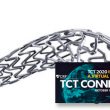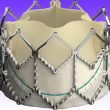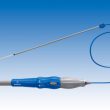Following with aspirin alone after a short period of dual antiaggregation therapy (DAPT), 1 to 3 months, did not increase ischemic events in patients receiving a Xience stent while significantly reducing bleeding. This study endorses the safety of short DAPT with contemporary drug eluting stents (DES) in patients presenting high bleeding risk. The XIENCE Short<a href="https://solaci.org/en/2020/10/21/tct-2020-xience-in-favor-of-short-dual-antiaggregation-therapy-with-high-bleeding-risk/" title="Read more" >...</a>
Size Does Matter for Long Term ViV
The size of the original bioprosthetic valve impacts long term mortality, as does the type of bioprosthetic valve used in percutaneous reinterventions. The number of patients with failed bioprosthesis is on the rise, mainly due to increased life expectancy. Valve-in-valve (ViV) transcatheter aortic valve replacement (TAVR) has become more and more common these days and<a href="https://solaci.org/en/2020/09/29/size-does-matter-for-long-term-viv/" title="Read more" >...</a>
Considerations for Optimal Device Selection in TAVR
Many studies have tried to answer the question about whether there is a superior device in transcatheter aortic valve replacement (TAVR). Today, there is no evidence to support such claim, and most patients will likely find operator experience more beneficial than any device per se. However, there are certain patients with specific characteristics that might<a href="https://solaci.org/en/2020/09/24/considerations-for-optimal-device-selection-in-tavr/" title="Read more" >...</a>
Valve-in-Valve: Good Evolution at Long-Term
Courtesy of Dr. Carlos Fava. In the last decades, there has been a marked increase in the use bioprosthetic valves in aortic position given their benefits over mechanical valves. However, long term follow-up has shown structural valve degeneration (SVD). Given the risk of a second surgery after TAVR, valve-in-valve (ViV) has been on the rise,<a href="https://solaci.org/en/2020/08/19/valve-in-valve-good-evolution-at-long-term/" title="Read more" >...</a>
After 8-year Followup, Good News for the Self Expandable Valve
As the transcatheter aortic valve replacement (TAVR) gains ground in lower risk populations and with better survival rate, concern over its durability has grown. This study brings us data and good news on the first-generation self-expandable valve after quite a long follow up. It included 990 inoperable or high-risk patients treated with CoreValve in 8<a href="https://solaci.org/en/2020/07/22/after-8-year-followup-good-news-for-the-self-expandable-valve/" title="Read more" >...</a>
EuroPCR 2020 | Aortic Valve in Valve in the Long Term
The outcomes of this work are important to plan valve replacement with the largest possible prosthesis allowed by patient anatomy in the index procedure. As a worldwide trend, increasingly more patients are receiving bioprostheses, which have improved a lot but still tend to become deteriorated and require a valve-in-valve procedure if the patient is no<a href="https://solaci.org/en/2020/07/13/europcr-2020-aortic-valve-in-valve-in-the-long-term/" title="Read more" >...</a>
TAVR: Balloon-Expandable or Self-Expanding Valves, Which Is the Answer?
Courtesy of Dr. Carlos Fava. Transcatheter aortic valve replacement (TAVR) has shown benefit and is currently moving towards low-risk patients, as well as bicuspid aortic valves and (to a lower extent) aortic regurgitation. However, we must ponder on which valve should be used on each patient: balloon-expandable (BE) or self-expanding (SE) valve? They represent different technologies<a href="https://solaci.org/en/2020/06/03/tavr-balloon-expandable-or-self-expanding-valves-which-is-the-answer/" title="Read more" >...</a>
Aligning Prosthetic Valves to Native Commissures: The Secret to Coronary Artery Obstruction?
Preventing coronary artery obstruction during transcatheter aortic valve replacement (TAVR) continues to be a challenge. There are techniques to prevent (or at least reduce) this from happening, which could be catastrophic. However, they all somehow fall into palliative care, that is, they will merely provide relief, rather than a cure. Commissure overlapping and the resulting<a href="https://solaci.org/en/2020/05/26/aligning-prosthetic-valves-to-native-commisures-secret-to-coronary-artery-obstruction/" title="Read more" >...</a>
Technological Improvements in Valves Translate into Clinical Results
Three generations of self-expanding valves, three different prognoses for our patients. Design improvements and better materials in self-expanding, supra-annular aortic valves, and their better results, have allowed for the expansion of the indication for transcatheter aortic valve replacement (TAVR). Particularly, the addition of a pericardial skirt improves annular sealing and results in a significantly low<a href="https://solaci.org/en/2020/04/08/technological-improvements-in-valves-translate-into-clinical-results/" title="Read more" >...</a>
AHA 2019 | Sapien vs Evolut: A Head-to-Head Study Seems Mandatory
Two French registries have carried out a propensity matched comparison which suggest differences between balloon-expandable valves (BEV) and self-expandable valves (SEV) in hard end points such as mortality. The only FDA approved commercially available transcatheter heart valves in the US are the BE Sapien 3 (Edwards Lifesciences) and the SE CoreValve Evolut PRO (Medtronic). Both<a href="https://solaci.org/en/2019/11/27/aha-2019-sapien-vs-evolut-a-head-to-head-study-seems-mandatory/" title="Read more" >...</a>







